
“The Man Behind the Artwork” by JD Hillberry
Charcoal and Graphite on White Watercolor Paper – 16″ x 20″
This self portrait has been my logo for over 20 years.
Incredible Artist
This is the first of a three part interview with one of the world’s greatest living pencil realism artists; JD Hillberry. JD is an incredible artist and the high standard of drawing ability demonstrated particularly in his Tromp l’eol (fool the eye) drawings that he is best known for reflects his life-long dedication to realism drawing. His artworks titled ‘Fooled’ and ‘Let’s Go Fly A Kite’ are featured in North Light Book’s ‘Strokes Of Genius’ 2013 a popular hard cover book of today’s best pencil artists.
Drawing From Childhood
JD has been drawing since a very young child and became a full time professional artist in 1989. Since that time JD has won over 50 awards in nationally acclaimed juried art shows and competitions. He is the author of ‘Drawing Realistic Textures in Pencil’ published in 1999 has sold 70,000 copies and is translated into several languages. His work can also be found in other publications such as ‘Incredible Optical Illusions’, by Nigel Rodgers Quarto Publications, London, England and ‘Eye Twisters’, by Burkard Polster Constable and Robinson Publications, London, England. His work has also been featured numerous times in ‘The Artist’s Magazine.’

“Fooled” by JD Hillberry
Charcoal, Graphite and Carbon on White Watercolor Paper – 14″ x 11″
The idea of this drawing incorporates several layers of deception. The butterfly may have mistaken a photo of a flower for the real thing, and you, the viewer, may have been fooled as well, since the entire image is drawn.
JD Hillberry’s artwork titled ‘The Man Behind The Artwork’ was placed on Billboards that were erected around the city when JD was chosen to be the featured artist at a huge art festival in Houston Texas (see image above.)
Understanding Charcoal & Graphite
Through his web site tutorials, technique book and workshops he has helped others to develop their skills and gain a deeper appreciation and understanding of the mediums of charcoal and graphite. In this first part of the interview with JD we get to learn more about his motivations for drawing when he shares some of his very early experiences with art as a young boy. It gives me great pleasure to share this information with you as we look deeper into the life of JD Hillberry. We also read about his opinions and beliefs on teaching others how to draw.
Interview with JD Hillberry by Cindy Wider:
Q: Hi JD Please tell us where you were born and where you are living now.
A: I was born on June 17th 1958 and raised in Riverton, Wyoming, USA and currently live in Erie, Colorado. By the way, I share the same birthday as M.C. Escher, one of my artistic influences. He was born in 1898 and died in 1972.
Q: JD, when did you first realise that you wanted to be an artist. How old were you and were there any significant influences or experiences in your life at that time?
A: My mother liked to draw as a hobby and I remember her creating some portraits of my brother and I. She taught me a little about value and shading when I was very young. I loved how drawing would quiet my mind and time would just fly.

“A String of Memories” by JD Hillberry
Charcoal and Graphite on White Watercolor Paper – 11″ x 14″
Tinker Toys, Yo-Yos, Jacks, and Lincoln Logs and are some of the toys that baby-boomers grew up with. These toys from the past represent a much simpler time that many people yearn for. A photo captures a moment in time, but I’ve drawn the Yo-Yo string in a way that links us to the past, when kids actually played with toys instead of looking at screens and pushing buttons.
From Musician to Artist
I never really considered becoming an artist for a living until much later in life. At age 12, I began playing the drums professionally in my uncles jazz band. I was quite certain I would be a professional musician my entire life. Growing up, I was known as “the musician”. Not many people even knew that I liked to draw but I spent quite a bit of time doing it.

“Inner Beauty” by JD Hillberry
Charcoal, Graphite and Carbon on White Watercolor Paper – 18″ x 14″
This drawing shows the illusion of notebook paper taped to some wood. The subject of the rose speaks to the illusion of beauty. True Beauty is always below the surface and true love is the ability to see the beauty within.
When I was around ten years old, I came across the work of M.C Escher (1898 – 1972). That got me interested in the paradoxes possible when representing three dimensional space on a 2 dimensional surface. My other art hero was William Harnett (1848 – 1892). He was one of the first American trompe l’oeil (fool the eye) painters of note. Trompe l’oeil is artwork so realistic that the viewer thinks that real objects are being displayed instead of two dimensional representations of those objects. Although it has taken quite a few years to develop my skills enough to pull it off, my most recent work is trompe l’oeil drawing.
Leaving College
I went to college to become a music teacher but decided after my sophomore year that it wasn’t for me. I quit school and went out “on the road” playing music in various clubs for the next 10 years. This was back in the day of lounge bands and I was playing in large hotel chains. I actually lived on the road in hotels over 45 weeks a year. My evenings were spent playing music and I liked to draw in the daytime. I actually made a little money selling portraits but it wasn’t my goal to become a professional artist. I didn’t even think that would be possible.
Choosing Art
However, while touring the country playing music, I met my wife, Vicki (the groupie I couldn’t shake) and we both realized that being a traveling musician was not very conducive to raising a family. The only other thing I knew how to do was draw. So, I set out to see if I could make it as an artist. After we got married we decided that I would try it for one year and if I didn’t make a profit, I would get a “real” job. I had never had one of those, and the fear of it inspired me to learn how to turn my art hobby into a business. I barely made any money that first year and was literally a starving artist.
My wife doesn’t let me call myself that anymore since I’m getting fatter every year. Luckily, I managed to make enough doing commissioned portraits to avoid that real job.

“Go Fly a Kite” by JD Hillberry
Charcoal, Graphite and Carbon on White Watercolor Paper – 14″ x 11″
In this trompe l’oeil drawing, the little stick man appears to have become real enough to make his own kite and fly it outside of the world in which he was created.
Self Taught Artist
Q: Did you study art within any formal institutions and if so what were those experiences like for you? For example; did you learn much there or does anything or anyone in particular stand out as significantly contributing to your expertise that you have developed with drawing? Or would you say you are more ‘self-taught’?
A: I’m a self-taught artist. That term means different things to different people. To me, it means, I haven’t ever had any formal training. I read books to learn how other drawing artists worked and to learn the basics of composition, anatomy and perspective. By learning from many different sources, I realized that there wasn’t just one correct way to do things. That was very liberating in that I could use what worked for me and discard the rest.
Art Styles of 1976

“A Work In Progress” by JD Hillberry
Charcoal, Graphite and Carbon on White Watercolor Paper – 20″ x 16″
“This drawing is a statement about how we are all in a state of growth and development. This has been a reoccurring theme in many of my pieces. It all begins with the tiny pencil in the smallest image on the tee shirt. In each larger image, I am depicted in various stages of creating myself until I’m real enough to reach out and sign the self portrait.”
Back in the 1976 when I first went to college, the big art movement being taught was that you needed to draw big and loose in order to express yourself. If I would have gone to an art school back then, most professors would have ridiculed my style and the way I was choosing to express my self through realism. I believe that an art education should teach the tools and techniques to help artists express themselves. To me, different styles of artwork are like different languages. Art instructors should teach the language the artist wants to learn, instead of teaching them what to say and how to say it. To this day, I think this is one of the most important things an artist can know.
Different Strokes
There is no right way or wrong way to create art. If it is expressing what you want to express, it is right. It’s the same thing with technique. Some instructors get very hung up on the right way or wrong way to hold your pencil. I don’t care if you are holding your pencil with your toes, if it is making the mark you want it to make then it’s correct. In my workshops, I teach my students that different ways of holding your pencil will effect the resulting line, and some ways are better for some lines than others, but there’s no right or wrong way – just different ways.
Blending & Textures
Another example is with blending. Some time ago, a strange idea surfaced that using blending techniques was “cheating”. I still get emails from art students telling me they love the effects I get but their teacher won’t let them blend. Blending is a technique used for softening pencil lines and creating graduated values and textures. It is just a drawing technique that has been around for centuries. It would be just as valid to say that NOT blending is cheating.
This ends the first of a three-part interview with JD Hillberry.
To read part two of this interview with JD Hillberry, please click the link below:
Let us know what your thoughts about JD Hillberry and his art on our Facebook page:
For more information about JD Hillberry:
Click the links below:
- Website: www.jdhillberry.com
- Facebook: /DrawingTechniquesJDHillberry
- LinkedIn: LinkedIn.com/JDHillberry





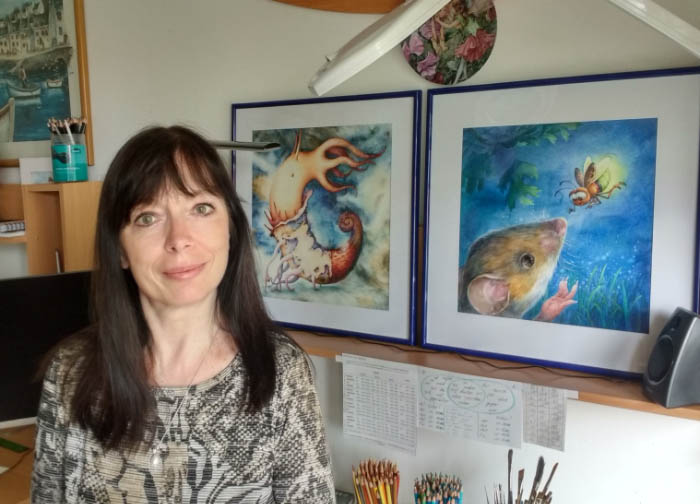
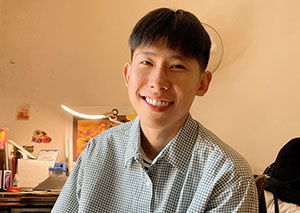


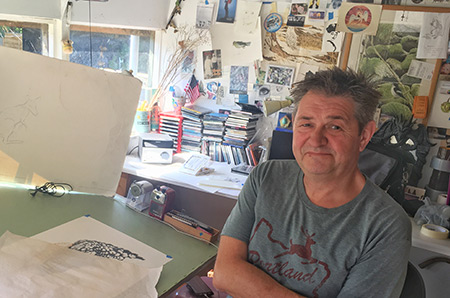
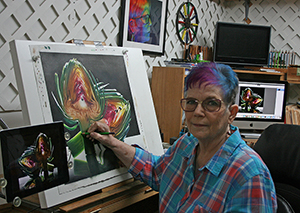
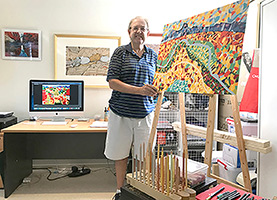
Thank you so much for interviewing this artist! He is one of my favorite artists, I love his work and so for me, it is really interesting to learn a bit more about his art journey. I love his compositions, fun and playful, yet thought provoking. The techniques he uses give his drawings amazing depth and are so realistic. I’m happy he didn’t go to art school:)
His message of “There is no right way or wrong way to create art. If it is expressing what you want to express, it is right” is liberating. I’m looking forward to the rest if the interviews!
WOW! Thank you for interviewing this artist. I was following JD Hillberry for some time and was hoping he will come close to my area with classes to watch him work in real life. I love his work and the realism just blows my mind. I can’t wait for next part of the interview.
Thank you for this inspiring interview!
I am still in awe for this artist!
Thanks Cindy for this wonderful interview with JD Hillberry. He is an amazing artist and I agree with Tannis in mentioning his message of “There is no right way or wrong way to create art – just different way’s”
What a great article, Cindy! I love JD Hillberry’s art very much. I hope he will come to VA area with his workshops so i can attend them.
Wow! Interviewing a legend. JD Hillberry has inspired me since the day I was a student and stumbled upon his website while researching what other artists were doing with graphite, and subsequently bought his book. Today, I introduce his book to my budding students so that he can inspire them as well. Without fail they are motivated and encouraged as I was. Thank you Cindy for this great 3 piece article so that we may know more about the man behind his impressive artwork.
Thank you so much for the flattering comments! And I’d like to thank Cindy for contacting me to do the article. She asked great questions – many that I’ve never had before. I started out conducting my workshops in the Denver Colorado area but in the past 2 years I’ve begun to travel more with them. You can sign up on my email list on my website to be notified of upcoming classes and video tutorials. I hope to meet all of you one day!
JD
Hi, have you ever been to Union N.J? Someone drew me a picture as a tip at the Swiss Chalet in Union NJ. in 1983 with your initials. I still have it framed on my wall.
You could certainly see your enthusiasm within the article you write.
The world hopes for even more passionate writers
like you who are not afraid to mention how they believe.
Always go after your heart.
How great to see you and your work featured!!!